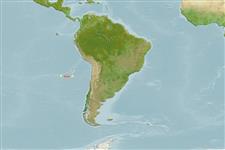Environment: milieu / climate zone / depth range / distribution range
Ökologie
seewasser benthopelagisch; tiefenbereich 180 - 400 m (Ref. 6181). Deep-water; 20°S - 27°S, 90°W - 81°W (Ref. 6181)
Southeast Pacific: known only from seamounts of Nazca Submarine Ridge and adjacent parts of Sala y Gomez Ridge.
Size / Gewicht / Alter
Maturity: Lm ? range ? - ? cm
Max length : 43.0 cm SL Männchen/unbestimmt; (Ref. 6181); max. veröff. Alter: 15 Jahre (Ref. 6204)
Rückenflossenstacheln (insgesamt): 18; Rückenflossenweichstrahlen (insgesamt): 15-18; Afterflossenstacheln 2; Afterflossenweichstrahlen: 12 - 14; Wirbelzahl: 34. Lateral line branching below the 5th to 7th spine of the first dorsal fin, usually ending below the third to the last spine of the first dorsal fin. The lower branch runs mid laterally, sometimes undulating on caudal peduncle. Body is entirely scaled at a length of over 20 cm SL. Pyloric caeca 7 or 8. Body color is brown with silvery tint; anterior 2 membranes of the first dorsal fin black, the rest of the fin black edged; the posterior part of the pectoral fin is black.
Feeds on squid and fish. Matures at about 25 cm.
Life cycle and mating behavior
Geschlechtsreife | Fortpflanzung | Ablaichen | Eier | Fecundity | Larven
Nakamura, I. and N.V. Parin, 1993. FAO Species Catalogue. Vol. 15. Snake mackerels and cutlassfishes of the world (families Gempylidae and Trichiuridae). An annotated and illustrated catalogue of the snake mackerels, snoeks, escolars, gemfishes, sackfishes, domine, oilfish, cutlassfishes,. scabbardfishes, hairtails, and frostfishes known to date. FAO Fish. Synop. 125(15):136 p. (Ref. 6181)
IUCN Rote Liste Status (Ref. 130435)
Bedrohung für Menschen
Harmless
Nutzung durch Menschen
Mehr Information
NamenSynonymeMetabolismusRäuberÖkotoxikologieFortpflanzungGeschlechtsreifeAblaichenSpawning aggregationFecundityEierEientwicklung
ReferenzenAquakulturAquakultur ProfilZuchtlinienGenetikElectrophoresesVererbbarkeitKrankheitenVerarbeitungNutrientsMass conversion
PartnerBilderStamps, Coins Misc.LauteCiguateraGeschwindigkeitSchwimmstilKiemenoberflächeOtolithsGehirngrößeSehfähigkeit
Tools
Zusatzinformationen
Download XML
Internet Quellen
Estimates based on models
Preferred temperature (Ref.
123201): 10.6 - 11.1, mean 10.8 °C (based on 10 cells).
Phylogenetic diversity index (Ref.
82804): PD
50 = 0.5078 [Uniqueness, from 0.5 = low to 2.0 = high].
Bayesian length-weight: a=0.00363 (0.00163 - 0.00807), b=3.10 (2.91 - 3.29), in cm total length, based on LWR estimates for this (Sub)family-body shape (Ref.
93245).
Trophic level (Ref.
69278): 4.5 ±0.62 se; based on food items.
Widerstandsfähigkeit (Ref.
120179): niedrig, Verdopplung der Population dauert 4,5 - 14 Jahre. (tmax=15).
Fishing Vulnerability (Ref.
59153): Moderate vulnerability (41 of 100).
